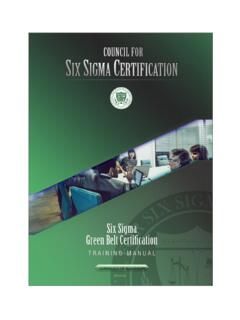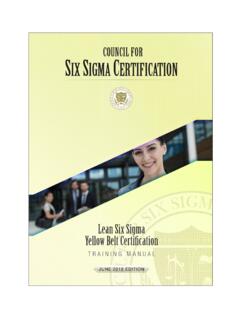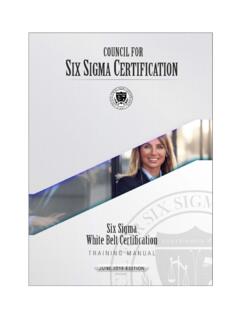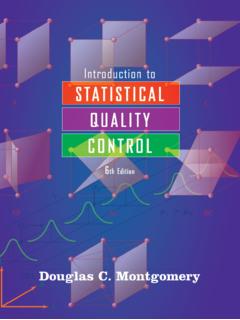Transcription of Six Sigma: A Complete Step-by-Step Guide: A Complete ...
1 I SIX sigma : A Complete Step-by-Step GUIDE ii 2018 The Council for Six sigma Certification. All rights reserved. Harmony Living, LLC, 412 N. Main St, Suite 100, Buffalo, WY 82834 July 2018 Edition Disclaimer: The information provided within this book is for general informational purposes only. While we try to keep the information up-to-date and correct, there are no representations or warranties, express or implied, about the completeness, accuracy, reliability, suitability or availability with respect to the information, products, services, or related graphics contained in this eBook for any purpose. Any use of this information is at your own risk. The author does not assume and hereby disclaims any liability to any party for any loss, damage, or disruption caused by errors or omissions, whether such errors or omissions result from accident, negligence, or any other cause. SIX sigma : A Complete Step-by-Step GUIDE iii Using the most recent edition in your workplace?
2 Because we continually attempt to keep our Handbook up to date with the latest industry developments, be sure to check our website often for the most recent edition at iv SIX sigma : A Complete Step-by-Step GUIDE v vi SIX sigma : A Complete Step-by-Step GUIDE vii 8 Six sigma , or 6 , is both a methodology for process improvement and a statistical concept that seeks to define the variation inherent in any process. The overarching premise of Six sigma is that variation in a process leads to opportunities for error; opportunities for error then lead to risks for product defects. Product defects whether in a tangible process or a service lead to poor customer satisfaction. By working to reduce variation and opportunities for error, the Six sigma method ultimately reduces process costs and increases customer satisfaction. In applying Six sigma , organizations, teams, and project managers seek to implement strategies that are based on measurement and metrics.
3 Historically, many business leaders made decisions based on intuition or experience. Despite some common beliefs in various industries, Six sigma doesn t remove the need for experienced leadership, and it doesn t negate the importance of intuition in any process. Instead, Six sigma works alongside other skills, experience, and knowledge to provide a mathematical and statistical foundation for decision making. Experience might say a process isn t working; statistics prove that to be true. Intuition might guide a project manager to believe a certain change could improve output; Six sigma tools help organizations validate those assumptions. SIX sigma : A Complete Step-by-Step GUIDE 9 Without proper measurement and analysis, decision making processes in an organization might proceed as follows: Someone with clout in the organization has a good idea or takes interest in someone else s idea. Based on past experience or knowledge, decision makers within an organization believe the idea will be successful.
4 The idea is implemented; sometimes it is implemented in beta mode so expenses and risks are minimized. The success of the idea is weighed after implementation; problems are addressed after they impact products or processes in some way in the present or the future. Beta testing is sometimes used in a Six sigma approach, but the idea or change in question goes through rigorous analysis and data testing first. The disadvantage of launching ideas into beta or to an entire population--without going through a Six sigma methodology is that organizations can experience unintended consequences from changes, spend money on ideas that don t end up working out as planned, and impact customer perceptions through trial-and-error periods rife with opportunities for error. In many cases, organizations that don t rely on data make improvements without first understanding the true gain or loss associated with the change.
5 Some improvements may appear to work on the surface without actually impacting customer satisfaction or profit in a positive way. The Six sigma method lets organizations identify problems, validate assumptions, brainstorm solutions, and plan for implementation to avoid unintended consequences. By applying tools such as statistical analysis and process mapping to problems and solutions, What is beta testing? Beta testing is the act of implementing a new idea, system, or product with a select group of people or processes in as controlled an environment as possible. After beta testers identify potential problems and those problems are corrected, the idea, system, or product can be rolled out to the entire population of customers, employees, or processes. The purpose of beta testing is to reduce the risks and costs inherent in launching an unproven product or system to a widespread audience.
6 WHAT IS SIX sigma ? 10 teams can visualize and predict outcomes with a high-level of accuracy, letting leadership make decisions with less financial risk. Six sigma methods don t offer a crystal ball for organizations, though. Even with expert use of the tools described in this book, problems can arise for teams as they implement and maintain solutions. That s why Six sigma also provides for control methods: once teams implement changes, they can control processes for a fraction of the cost of traditional quality methods by continuing the use of Six sigma tools and statistics. Six sigma as a methodology for process improvement involves a vast library of tools and knowledge, which will be covered throughout this book. In this section, we ll begin to define the statistical concept represented by 6 At the most basic definition, 6 is a statistical representation for what many experts call a perfect process. Technically, in a Six sigma process, there are only defects per million opportunities.
7 In percentages, that means percent of the products from a Six sigma process are without defect. At just one sigma level below 5 , or percent accuracy--processes experience 233 errors per million opportunities. In simpler terms, there are going to be many more unsatisfied customers. According to the National Oceanic and Atmospheric Administration, air traffic controllers in the United States handle 28,537 commercial flights In a year, that is approximately million flights. Based on a Five sigma air traffic control process, errors of some type occur in the process for handling approximately 2,426 flights every year. With a Six sigma process, that risk drops to errors. The CDC reports that approximately million surgeries are performed in the United States in a given Based on a accuracy rate, doctors would make errors in 11,976 surgeries each year, or 230 surgeries a week. At Six sigma , that drops to approximately 174 errors a year for the entire country, or just over 3 errors each week.
8 At Five sigma , patients are 68 times more likely to experience an error at the hands of medical providers. 1 Air Traffic, Science on a Sphere, National Oceanic and Atmospheric Administration. 2 Inpatient Surgery, FastStats, Centers for Disease Control and Prevention. SIX sigma : A Complete Step-by-Step GUIDE 11 While most people accept a percent accuracy rate in even the most critical services on a daily basis, the above examples highlight how wide the gap between Six sigma and Five sigma really is. For organizations, it s not just about the error rate it s also about the costs associated with each error. Consider an example based on Amazon shipments. On Cyber Monday in 2013, Amazon processed a whopping million Let s assume that each order error costs the company an average of $35 (a very conservative number, considering that costs might include return shipping, labor to answer customer phone calls or emails, and labor and shipping to right a wrong order).
9 Cost of Amazon Order Errors, 5 Total Orders Errors Average Cost per Error Total Cost of Errors million $35 $300, Cost of Amazon Order Errors, 6 Total Orders Errors Average Cost per Error Total Cost of Errors million $35 $4, For this example, the cost difference in sigma levels is still over $295,000 for the Cyber Monday business. For most organizations, Six sigma processes are a constant target. Achieving and maintaining Six sigma perfection is difficult and requires continuous process improvement. But even advancing from lower levels of sigma to a Four or Five sigma process has a drastic impact on costs and customer satisfaction. Let s look at the Amazon Cyber Monday example at other levels of sigma . 3 Siegel, Jacob, Amazon sold 426 items per second during its best ever holiday season, Boy Genius Reports, Dec. 26, 2013. WHAT IS SIX sigma ?
10 12 sigma Level Defects per Million Opportunities Estimated Cyber Monday Defects Total Cost (at $35 estimate per error) One sigma 690,000 25,392,000 $888,720,000 Two sigma 308,000 11,334,400 $396,704,000 Three sigma 66,800 2,458,240 $86,038,400 Four sigma 6,200 228,160 $7,985,600 Five sigma 233 8, $300,104 Six sigma $4,379 At very low levels of sigma , any process is unlikely to be profitable. The higher the sigma level, the better the bottom line is likely to be. Organizations and teams can calculate the sigma level of a product or process using the equation below: Consider a process in a marketing department that distributes letters to customers or prospects. For the purposes of the example, imagine that the process inserts 30,000 letters in preaddressed envelopes each day. In a given business week, the process outputs 150,000 letters. The marketing department begins receiving complaints that people are receiving letters in envelopes that are addressed to them, but the letters inside are addressed to or relevant to someone else.












